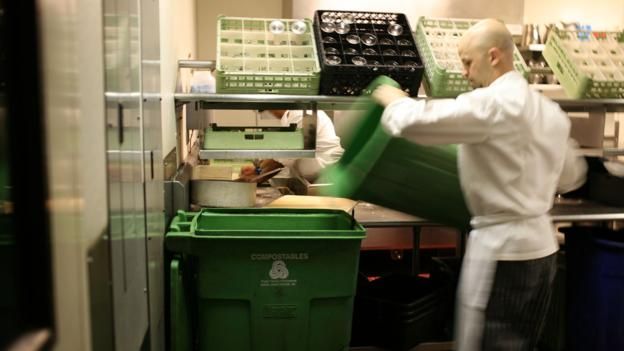全球最佳的生态城市
BBC林德赛·加洛威,2016年1月19日

俯视开普敦(图片来源: Eric Nathan/Getty)
从修建大量自行车道、开设本地农产品市场到保持空气清洁,一座城市的环保举措不仅能减轻地球的环境压力,还能让城中居民从中获益。
经济学人智库推出的《西门子绿色城市指数》(Siemens Green City Index)表明,全球最环保的城市在二氧化碳排放、交通出行多样化、水和垃圾管理、以及整体环境治理上都赢得了高分。
不同城市的可持续发展优势各不相同,因此我们与全球排名靠前的绿色城市的居民进行对话,请他们谈谈各自的生活感受。
加拿大不列颠哥伦比亚省温哥华市
与规模相近的其他城市相比,温哥华在二氧化碳排放和空气质量上得分奇高。这部分得益于该市对大力发展绿色能源的重视,以及利用水电的缘故。温哥华已经承诺,到2020年把污染物排放量进一步降低33%。

温哥华的花园遍布城市各处。(AFP/Getty)
对于1985年从卡尔加里(Calgary)移居而来的温哥华居民,同时也是绿色简讯(Green Briefs)博客博主的罗尼·克雷格(Lorne Craig)来说,这条承诺显得稀松平常。“从20世纪60年代开始,温哥华就一直是激进环保文化的大本营,并且被公认为绿色和平组织的诞生地,”他说。“环绕温哥华四周的山峰提示着这里的每个人,我们都是美丽自然中的一员。”
与其他很多不断修建高速路,力图为驾车者提供方便并扩大城市面积的城市不同,温哥华仍然对静谧悠闲的传统城市生活方式情有独钟,这一点从格兰维尔岛(Granville Island)的开发过程中可见一斑。行人在格兰维尔岛上享有充分自由,岛上居民经常光顾大型公共市场和美术馆。
温哥华市内众多社区也为绿色生态建设大开方便之门。温哥华修建了遍布全市的专用自行车道,骑车人可以借此方便安全地游遍全城。西十大街(West 10th Avenue)的居民更是习惯了骑自行车、电动摩托车甚至独轮车外出。克雷格说,位于温哥华城东的两个社区:商业大道(Commercial Drive)和斯特拉斯克纳(Strathcona)都属于政治上更为活跃的“左翼环保主义”地区,城西的基茨拉诺(Kitsilano)和城南的主街(Main Street)社区则属于“普锐斯环保主义(Prius: 丰田的一款混合动力轿车)”地区–这里的人收入更高,更倾向于采取较为平和的环保举措。
巴西库里提巴
在《西门子绿色城市指数》所提及的所有南美洲城市里,只有巴西库里提巴的得分超过平均值。该市于20世纪60年代建设了全球首个大规模快捷巴士系统,并在之后的80年代推行了全球领先的垃圾循环利用计划。目前,该市在环保领域依然保持着前瞻性。库里提巴的公共交通出行比例很高,使之成为《西门子绿色城市指数》里空气质量最好的城市之一。

库里提巴植物园。(David Silverman/Getty)
然而,15年前从伦敦移居到库里提巴,该市生活博客“Head of the Heard”博主的史蒂芬·格林(Stephen Green)却说,该市仍然有很多工作要做。库里提巴计划新建地铁系统和300公里专用自行车道,需要更多资金完成上述高成本建设项目。尽管如此,与南美其他城市相比,“库里提巴是一个优秀的城市”,格林说。
格林住在位于库里提巴市中心的梅赛斯(Merces)社区,住在这里的大多是中老年人。“这里每周日开放集市,公共交通很方便,附近还有市内最大的公园,”他说。库里提巴的农产品市场都是非固定流动市场,各社区的居民都有机会方便地买到本地生产的有机食品。
丹麦哥本哈根
尽管其他两个斯堪的纳维亚城市奥斯陆和斯德哥尔摩紧随其后,但是哥本哈根仍然继续蝉联欧洲最环保城市的桂冠头衔。几乎所有哥本哈根居民的住所距离最近的公共交通线路都不足350米,同时半数以上的居民都骑自行车上下班。因而,哥本哈根的二氧化碳排放量远低于其他同等规模的城市。

库里提巴植物园。(David Silverman/Getty)
土生土长的哥本哈根人米亚·克里斯琴·杰森·彼得森(Mia Kristine Jessen Petersen)说,哥本哈根全市范围都适宜骑行,西北部的北桥区(N?rrebro)和西部的腓特烈斯贝区(Frederiksberg)尤其重视自行车交通。“这两个区花大价钱修了‘绿道’- 供步行和骑行的9千米长专用道路,”她说。“‘绿道’让骑行客能够安全快捷地在城区内穿行,路两边的景色也非常美丽。但是,这条专用路并不只是人行道和自行车道而已,它的沿途分布有很多公园、运动场、长椅和高低起伏的地形,每个转弯处的景色都各不相同。”“绿道”的终点位于距离市中心4千米的瓦尔比(Valby),这个地方以其遍布各处的公园、学校和安全的街道而著称。
除了对骑行情有独钟外,哥本哈根人还热衷于垃圾循环利用和堆肥处理,以及节约电力和热力。“丹麦人把大自然看作是神圣的庇护所,”彼得森说。“我们总是竭尽所能保护城市自然环境。”
美国加利福尼亚州旧金山
《西门子绿色城市指数》将旧金山列为北美地区最环保的城市。作为19世纪“山岳协会”(Sierra Club)环保组织的诞生地,旧金山拥有源远流长的环保意识。旧金山强制要求对垃圾中的可回收垃圾和可堆肥垃圾进行分类,从而使该市的垃圾重复利用率高达77%,在全世界居于首位。

旧金山餐馆的垃圾处理。(Justin Sullivan/Getty)
“旧金山周围有着美不胜收的自然景色,同时,旧金山也有进步和开放的传统,”9年前从哥斯达黎加移居到旧金山的多娜·斯基(Donna Sky)说。她创办了豆酱生产企业Love & Hummus。为了迎合那些十分关注食品生产过程,并且喜欢食用本地生产的食品的居民的需求,该公司使用的原料都产自本地。
为此,旧金山许多社区都开办了专供本地农场主销售农产品的市场,每个市场都各有特色。北潘汉多尔(North of the Panhandle)拥有一个常年开放的市场,而米慎区(Mission)和海特-阿什伯里(Haight-Ashbury,以嬉皮文化和维多利亚年代建筑知名)的市场则季节性开放。
湾区长住居民,曾担任北潘汉多尔社区委员会(North of Panhandle Neighborhood Association)主席的嘉利·波兰德(JarieBolander)说,上述三个区的地势都很平坦,因此很适宜骑行。“这些社区都各有其特色,”他说。“北潘汉多尔区居民大多是热心于公共事业的年轻专业人士,而海特区则是中老年嬉皮士和消息灵通人士的聚居地。”
南非开普敦
南非第二大城市开普敦正在推行非洲大陆规模最大的环保计划,目标在于促进节能技术的推广普及,并扩大可再生能源的使用。2008年,南非首个商业化风电场开始向开普敦供电。目前,南非已经制定了到2020年将可再生能源在所有能源种类中的比例提高到10%的目标。
这些努力正在改变开普敦城市生活的面貌。“开普敦建设了更多专用自行车道和农产品市场,厨师们也更多地使用本地生产的调味品和农产品,”2013年从纽约移居到开普敦, 南非博客博主的萨拉·汗(Sarah Khan)说道。与此同时,她认为开普敦的公交系统和电力供应仍然有进一步改善的空间。

开普敦坎普斯湾的骑行客。(Franz Marc Frei/Getty)
开普敦人热爱大自然,喜欢骑上自行车感受户外生活。“开普敦最适宜骑行的地方无疑是海角点(Seapoint)和绿点(Greenpoint),这两个地方都建有高质量的自行车道,”骑行运动倡导机构开普敦自行车骑行协会(Bicycle Cape Town)创始人兼主席雷奥尼·莫维斯(Leonie Mervis)说。尽管开普敦市中心的专用自行车道数量不多,但是允许自行车免费借用该市My CiTi快速巴士专用车道,这样,人们无需开车也能方便抵达市区各处。
莫维斯住在距离开普敦中央商务区20公里的社区Hout Bay,这里住着许多创意人士和环保人士。“社区里很多人自己安装了太阳能发电系统,还自己种菜,”莫维斯说。“我们还有一个环保委员会负责扶持环保计划,并负责对周围开阔的自然空间进行修复和保护。”
(责编:凯露)
The world’s most eco-friendly cities
By Lindsey Galloway,19 January 2024
From offering plentiful bike paths and thriving farmers’ markets to ensuring cleaner air, a city’s environmental efforts don’t just help the planet – they benefit residents too.
According to the Siemens Green City Index, an ongoing project researched by the Economist Intelligence Unit, the world’s greenest cities score high marks in CO2 emissions, transportation options, water and waste management, and overall environmental governance.
Different urban areas have different sustainability strengths, so we talked to residents in the top-ranked cities across the globe to find out what living in them is like.
Vancouver, British Columbia
Compared to other cities of its size, Vancouver scored incredibly well in C02 emissions and air quality, due in part to the city’s emphasis on promoting green energy and its use of hydropower. Vancouver has vowed to reduce emissions by 33% by 2020.
That commitment doesn’t surprise resident Lorne Craig, who moved to the city from Calgary in 1985 and writes the Green Briefs blog. “Vancouver has been home to a deeper green counter-culture since the 1960s and is recognized worldwide as the birthplace of Greenpeace,” he said. “Mountains tower over the city. It reminds everyone here that we are part of something bigger and more beautiful.”
As other cities continued building freeways that promoted driving and sprawl, Vancouver remained committed to urban living, as evidenced by the development of Granville Island, a pedestrian-friendly peninsula where residents frequent large public market and art studios.
Plenty of other Vancouver neighbourhoods are eco-friendly too. A large network of bike routes makes cycling around town easy, especially West 10th Avenue, where people regularly cruise on bikes, electric scooters and even unicycles. Craig said the neighbourhoods of Commercial Drive and Strathcona, both east of downtown, are “more left-wing green” – meaning, more politically active – while Kitsilano to the west and the Main Street neighbourhood to the south of downtown are “more the Prius type of green” – wealthier, with a more laid-back approach to activism.
Curitiba, Brazil
Of all the cities on the South American Siemens Index, only Curitiba scores above average in the green rankings. After building one of the planet’s first large-scale, rapid-transit bus systems in the 1960s and developing a world-leading recycling program in the 1980s, the southern Brazilian city continues to be environmentally forward-thinking. In fact, the heavy use of public transportation means Curitiba has one of the highest air qualities in the index.
However, the city could use some revitalization, according to resident Stephen Green, who moved to Curitiba 15 years ago from London and writes the city lifestyle blog Head of the Heard. While Curitiba plans to build a metro system and an additional 300km in bike routes, the projects are expensive and the city needs more funding to complete them. Still, compared to other cities in the region, “Curitiba is excellent,” Green said.
Green lives in Merces, a traditional city-centre neighbourhood that’s popular with older residents. “We have a good market on Sundays, decent public transport links and the biggest park in the city is close by,” he said. Farmers’ markets move around the city, helping residents find local organic produce.
Copenhagen, Denmark
Though fellow Scandinavian cities Oslo and Stockholm trail close behind, Copenhagen consistently ranks as Europe’s greenest city. Almost all of the residents live within 350m of public transportation and more than 50% regularly use a bicycle to commute. As a result, Copenhagen has extremely low C02 emissions for a city its size.
While the entire city is bike-friendly, the districts of N?rrebro in the northwest and Frederiksberg in the west are especially committed to cycling, said Copenhagen native Mia Kristine Jessen Petersen. “They've spent a lot of money creating “Den Gr?nne Sti [the Green Path], a 9km-long path for walking and biking,” she said. “The Green Path is made to help cyclists get through the city fast and easy in beautiful scenery. But the path isn't just a path; it’s also filled with parks, playgrounds, benches and different terrain, so the scenery shifts at every turn.” Gr?nne Sti ends in Valby, 4km outside of downtown, a district popular with families who live there for its plentiful parks, schools and safe streets.
In addition to their love of cycling, Copenhagen residents are passionate about recycling and composting, as well as conserving electricity and heat. “Danes see nature as a sacred haven,” Petersen said. ???We do whatever we can to take care of the nature we have in the cities and to get more.”
San Francisco, California
San Francisco ranks as North America’s greenest city in the index. The city has a long history of environmental consciousness stretching back to the founding of the Sierra Club environmental group in the 19th Century. San Francisco has a 77% recycling rate, one of the highest in the world, made possible through city mandates requiring the separation of recyclable and compostable materials from regular garbage.
“We are surrounded by stunning natural beauty, and we have a history of progressiveness and open-mindedness,” said Donna Sky, who moved to the city from Costa Rica nine years ago and founded the locally produced hummus company Love & Hummus. Local farms also contribute: Many residents care where and how their food is produced and strive to eat food produced nearby.
To that end, many neighbourhoods have their own farmers’ markets, each with a distinctive character. North of the Panhandle – NoPa for short – has a market that’s open throughout the year, whereas the Mission and central Haight-Ashbury (famous for its hippie culture and Victorian houses) have seasonal markets.
All three neighbourhoods are also bike-friendly due to their flat topography, said Jarie Bolander, a long-time Bay Area resident and past president of the North of Panhandle Neighborhood Association. “Each of these neighbourhoods has its own unique vibe,” he said. “NOPA is primarily young professionals and civically minded, while the Haight is a healthy mix of aging hippies and hipsters.”
Cape Town, South Africa
South Africa’s second-largest city is making some of the biggest environmental strides in Africa, in part by pushing for more energy conservation and a greater use of renewable resources. In 2008, Cape Town started using energy from the country’s first commercial wind farm and now aims to get 10% of its energy from renewable resources by 2020.
These efforts are transforming life in the city. “More bike routes are becoming available, farmers markets are very popular, and chefs definitely place a premium on sourcing ingredients and produce locally,” said resident Sarah Khan, who moved to Cape Town from New York City in 2013 and writes The South AfriKhan blog. Still, she believes the city could do more to improve public transportation and prevent the electricity shortages that are becoming increasingly common.
Locals tend to have an “outdoorsy nature” and aren’t afraid to hop on a bike to get around. "The most bike-friendly areas to live within the city are definitely Seapoint and Greenpoint, where there is great cycle infrastructure," said Leonie Mervis, the founder and director of urban cycling campaign Bicycle Cape Town. Though the city centre itself doesn't have as many dedicated cycling routes, bikes are allowed for free on the My CiTi rapid bus service, making the city easy to get around in without a car.
Mervis lives in Hout Bay, a neighbourhood 20km south of the central business district that’s home to many creative types and environmentally conscious residents. "Many people living in our community have solar energy systems and grow their own vegetables," Mervis said. "We also have an environmental committee that works to support green initiatives and rehabilitate and care for the surrounding open space system."